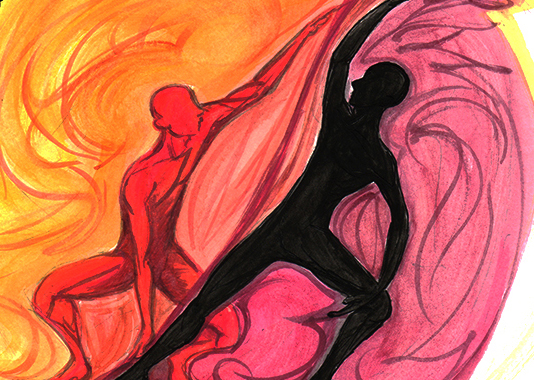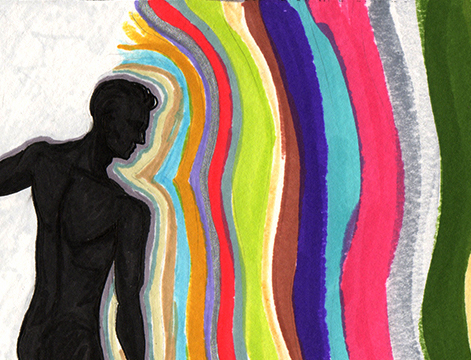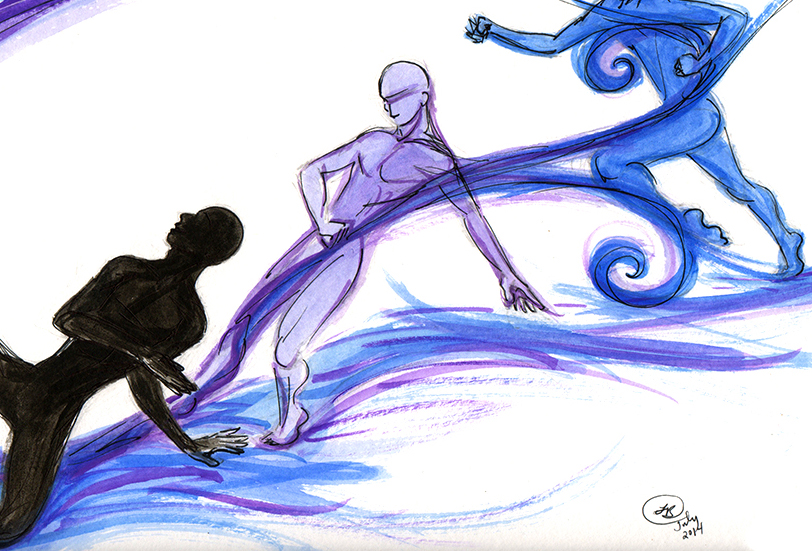Respecting Sexual Boundaries in Contact Improvisation
An Interview with Brooks Yardley
ILLUSTRATIONS BY LIZ BRENT
Brooks Yardley is a practitioner of contact improvisation in Canada who published the online zine “Respecting Boundaries/Coexisting Genders: Women’s Experiences of Feeling Unsafe in Contact Improv.” In this interview, Brooks shares why they felt it was important to create the zine, and how the contact community can discuss and address unwanted sexual energy on the dance floor.
~~
What is your own dance background? How long have you been practicing contact improv?
Ten years ago, I took a class called Body and Imagination at Concordia University. That was how I started dancing. I’ve been practicing contact improv as part of the Montreal community ever since.
Why did you decide to put together “Respecting Boundaries/Coexisting Genders”?
There is one experience in particular that had a profound effect on me. I invited a friend to come to the weekly jam to try contact improv. She was hesitant, but decided to give it a try. She is an exquisitely sensitive soul, and when I danced with her for the first time, I felt that she had a natural ability to listen carefully with her body, which made me feel even worse about what happened to her. She danced with a man who became sexually aroused during the dance. There is nothing wrong with sexual arousal, but instead of stopping the dance and excusing himself, which is what he should have done, he actually pressed his erect penis against her body during the dance. As you can read in her contribution in the zine (Anonymous “E”), this was a traumatic enough experience for her that she didn’t try contact improv again for another five years.
I have repeatedly heard stories like this from women, and repeatedly witnessed situations on the dance floor that, to me, seem to be inappropriately pushing the boundaries of sexual energy. The accumulated discomfort and anger that I’ve felt in knowing these things are happening all the time brought me to a place of just feeling totally fed up with it.
How did you collect the stories in the zine? What was your editorial process?
I basically just posted a call on Facebook. That was how I got many of my contributors. I also made announcements at jams and contact events. It was disturbingly easy to find people who had stories to tell.
Kinga Michalska, another dancer in Montreal, helped me with editing and putting all the contributions together in final form. I recruited some bilingual friends to help with translating the French contributions into English and vice-versa. The whole thing was a community effort.
What kinds of subsequent reactions have your gotten?
The most common reaction I’ve encountered is gratitude. People are grateful to see this issue have more visibility, and for the zine to add to the discourse about fuzzy boundaries in contact improv. Some folks have had uncomfortable experiences but never talked about it before. I think it legitimizes their stories, to be able to say, “Look, there is a whole zine about this problem, my experience is real.”
There have been other reactions, of course. The most memorable one for me was from an older male friend who made the argument that the zine contained many examples of ageism. He asked whether it would be acceptable to discriminate based on race, religion or disability in the way many contributors seemed to be discriminating against older men, exclusively due to their age and gender. I felt sympathy for him, because I perceive him to be an ally — not just a safe person, but a very fun person to dance with! But younger women who don’t know him probably avoid dancing with him just because of his age and gender, and that isn’t fair to him. However, ultimately I support a woman’s right to “discriminate” against older men in order to protect themselves from unwanted sexual attention. This is an excerpt from the long email I wrote back to him:
“I think the bottom line is that these are simply women’s experiences. This is not a zine that is intended to be philosophical or abstract, in which case it might be more arguable. But their experiences are not really arguable, in my opinion. It just seems to be a fact that often the discomfort comes from receiving unwanted sexual attention from older men, and I think these women have every right to feel that discomfort, to share it, to ask of the community to be aware of it, and to support them in feeling safer in a space where they often do not feel safe in the presence of […] older men.”
Do you think the level of inappropriate sexuality in contact improv is getting worse, or has it always been an aspect of the form?
It seems to me it’s been the same for as long as I’ve been dancing. My hope is that talking about it more will reduce the incidents of inappropriate sexual energy on the dance floor.
Do you think this issue is specific to certain contact scenes, or is it ubiquitous across the dance form?
At the moment, I’m living in Chisasibi, Quebec, a small town with no contact improv community. But my home community is Montreal, so I know that scene the best. It is definitely a problem there, and the conversations I’ve had with people from other communities suggests to me that the problem is ubiquitous.
The intimate nature of contact improv is already scary to newcomers. What would you say to someone who might read your zine but has never done contact improv?
I’ve asked myself this question many times, and I haven’t come up with an easy answer. I don’t want people to be scared off by reading all these stories of uncomfortable experiences, but I want them to be aware of the real possibility that people may do inappropriate things. What I would say to someone would depend on who I’m speaking with, but in general I think I would share with them some of the profoundly positive things about contact, and at the same time do my best to help them feel prepared for whatever energies they might encounter on the dance floor.
What are some ways that contact jams might be conducted differently so as to reduce inappropriate sexual advances?
Glad you asked! I wrote the final article in the zine where I enumerate some suggestions for contact communities on how to create a safer environment. These suggestions include advice for individuals as well as for the community as a whole. For individuals, I touch upon what to do when you feel sexual energy in your body and, on the other hand, what to do if you feel uncomfortable in a dance. For communities, I have suggestions like designating resource people for active listening and conflict resolution, and I encourage teachers to put greater emphasis on addressing the issue in their classes.
I am sure there are other options on how we can reduce these incidents. I encourage people to have conversations in their communities about how they want to address the issue.
~~




4 Responses to “Respecting Sexual Boundaries in Contact Improvisation”
Thanks for sharing this Denise! I really appreciate your perspective and suggestions, and hope other readers do as well!
In order for any space to be safe, there have to be boundaries clearly stating that expressing/acting out sexual energy, including on someone else, is not acceptable. The improv movement space is not the space for this type of behavior. Feelings are one thing, behavior is another. Everyone is responsible for their behavior, including the expression of their sexual energy. It is a responsibility of the facilitator/host to be very clear about that up front when it comes to contact improv, especially if participants do not know each other. The burden should not be placed on someone to talk about being uncomfortable with this type of behavior (many people are not ready to do that).
I think facilitators should ask therapists (especially ones who have clear sexual boundaries and understand what healthy sexuality is) how to make spaces safe . I find artists (I am one) often do not know how to do this. Boundaries are often squishy in a variety of artistic environments, which can limit the flow of creative energy because of the lack of safety (along with other negative consequences that can be explained to participants).
Also, I think it should be clearly stated how the facilitator will address this issue if it is witnessed, or they are told about it happening (the person acting out sexually will be asked to leave). There should be no allowances for the person to enter the space again, because they have violated the boundary of sexual safety in that space (and perhaps an individual, too). This is not a safe person, because they cannot maintain healthy sexual boundaries in this type of environment. They are not in a place/not ready to participate in contact improv.
It’s unfortunate that people with poor sexual boundaries seek out spaces where they can get away with this type of thing. They are perpetrating on people sexually – both individually and as a group- and contaminating the safe container where creative energy is usually explored and flourishes.
If facilitators/hosts send this information to people ahead of time (boundaries and addressing violations of those boundaries), you might find that people who take advantage of these types of settings will self-select out ahead of time. There are clear, tactful ways of communicating in writing where it is acknowledged that this type of behavior has happened in contact improv settings, that the facilitator/host is committed to creating a safe space, these are the boundaries, what will happen if they are violated, etc. This will be a HUGE relief to victims and people who are afraid to come because of the fear of this type of violation happening (and people getting away with it).
I am a dancer and love to improvise, but am not planning on doing contact improv with people I am not familiar with. It’s too risky. People just do not generally know how to address these issues. Until there is a significant change in the culture of the contact improv community where the enforcement of sexual boundaries is the norm and expected, sending a clear message that this type of sexual perpetration will not be tolerated, I will not be participating.
Thanks Misa! I think these are great suggestions, and I’m so glad the interview resonated with you and your own community! I hope this helps others as well!
Thank you for raising awareness! I have avoided a community in our town that incorporates contact improvisation into their weekly practice exactly because of this texture/nuance. In order to play comfortably, safety is a must, and unwanted sexual energy is very difficult for women who are trauma survivors. One out of 4 women will experience abuse before 18 and 1 out of 6 men will experience the same. http://nctsn.org/nctsn_assets/pdfs/caring/ChildSexualAbuseFactSheet.pdf
By allowing unwanted sexual energy in the creative space makes no sense to me. Especially given how moving the body can be such a powerful medium for healing. Yes, if one is in recovery, one can take personal responsibility and avoid settings such as this, but why not integrate into the culture a container of s a f e t y f i r s t! It could be as simple as an opening circle where the intention is set and a frank discussion of individuals that are not comfortable with sexual energy. Those who have a difficult time controlling this know not to engage with these individuals. Or, have a sexual energy okay night/session, and a night/session when the libido is mindfully checked at the door. Have your sex session before the improv session!
Comments are closed.